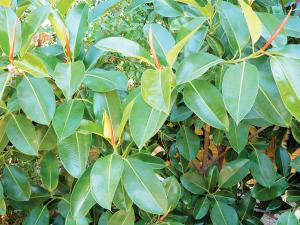Rubber tree plants are low-care in the home
It’s hard to predict what will make a song great other than it has a catchy tune. One such song won an Oscar for Best Original Song in the 1959 film “A Hole in the Head.” The song is “High Hopes,” and it tells of a few ridiculous situations where animals perform seemingly impossible acts, such as a ram that knocks down a dam and a single ant that moves a rubber tree plant. While we might not sing the praises of indoor ants, we might applaud the rubber tree plant (Ficus elastica). This popular house plant has large, thick, dark green or burgundy eight-inch-long oval leaves.
This easy-to-care-for houseplant not only lives in low light, but needs little care. As a bonus it can help purify the air.
This durable houseplant is a member of the fig family, and often called the India rubber plant because it is originally from northeast India, though it grows from the eastern Himalayas to Malaysia and Indonesia. Rubber tree plant is a good choice for shadier areas in the home, though you should avoid very dark places, because this can cause the plant to become spindly and weak. While they can reach up to 10 feet tall even indoors, they are easily kept in bounds with pruning.
Like most houseplants your rubber tree plant does best in a well-drained potting soil.
Keep the soil moist, but not soaked. Water the plant until the water drains out of the bottom of the pot. How often you water depends on the humidity and temperature of your house. Use lukewarm water to prevent shocking the roots and harming the plant.
Water once a week and adjust how often you water by checking how quickly the soil dries out. You will find that the rubber tree plant needs a little less water in the cooler months when the plant growth slows down.
These low-care plants get by with very light fertilizer. Apply a good water-soluble fertilizer at half strength about once a month during spring and summer and every other month the rest of the year.
If your rubber tree plant outgrows its pot, transplant it into a slightly larger pot in the spring when the roots are actively growing.
You can propagate rubber tree plants with cuttings or air layering. Take a six- or eight-inch cutting with at least two sets of leaves and carefully remove the lower set of leaves. Dip the cutting into a rooting hormone powder and plant it in a small pot. Water well and cover the pot and all with a loose plastic bag to help hold in moisture.
The milky sap can cause reactions in some people, so you may want to wear gloves when working with these plants. For this reason keep rubber tree plants away from children and pets.
Rubber tree plants are rarely bothered by insects or disease, perhaps because of that same disagreeable sap.
Sometimes when you move any houseplant to a new location it can cause leaves to yellow and die. Avoid placing any houseplants in drafts or in the path of heating vents and air conditioning outlets.
In nature, the leaves are constantly washed by rain. Indoors you should frequently gently wipe off the leaves with a damp cloth. Never apply any leaf shine or wax to leaves, as this can clog pores and actually hurt the plants.
While an ant might never move a rubber tree plant, you can have “high hopes” that your rubber tree plant will grow and even purify the air. Something an ant can’t.























































